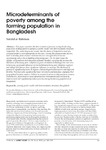Microdeterminants of Poverty among the Farming Population in Bangladesh
Date
2009-12Author
Subject
Metadata
Show full item recordAbstract
<jats:p> This paper examines the determinants of poverty among the farming population of Bangladesh by applying a probit model with heteroscedastic structure (hetprobit). The model diagnostic reveals that the choice of hetprobit instead of a standard probit is more appropriate in this case. Among the socioeconomic factors, land ownership, farm resource endowments and non-agricultural income significantly reduce the probability of becoming poor. On the other hand, the number of dependants and education of female members significantly increase the likelihood of becoming poor. Adoption of green revolution technology does not seem to have any significant influence on the likelihood of being poor. However, regional and village level factors have significant influence on poverty. The likelihood of poverty is significantly lower in regions with developed infrastructure and high soil fertility. Poverty is also significantly lower in Comilla and Jamalpur, implying that geographical location matters. Policies to promote land ownership and farm resource endowments, investment in rural infrastructure development and soil fertility improvement will significantly reduce poverty among the farming population of Bangladesh. </jats:p>
Publisher
Journal
Volume
Issue
Pagination
Recommended, similar items
The following license files are associated with this item:


